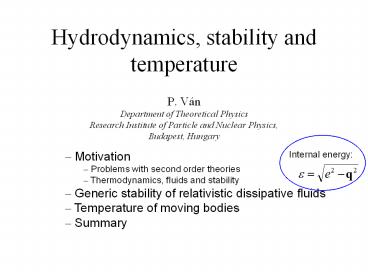Hydrodynamics, stability and temperature PowerPoint PPT Presentation
Title: Hydrodynamics, stability and temperature
1
Hydrodynamics, stability and temperature
- P. Ván
- Department of Theoretical Physics
- Research Institute of Particle and Nuclear
Physics, - Budapest, Hungary
- Motivation
- Problems with second order theories
- Thermodynamics, fluids and stability
- Generic stability of relativistic dissipative
fluids - Temperature of moving bodies
- Summary
2
Dissipative relativistic fluids
Nonrelativistic Relativistic Local
equilibrium FourierNavier-Stokes Eckart
(1940), (1st order) Tsumura-Kunihiro
(2008) Beyond local equilibrium Cattaneo-Vernotte
, Israel-Stewart (1969-72), (2nd order) gen.
Navier-Stokes Pavón, Müller-Ruggieri,
Geroch, Öttinger, Carter,
conformal, etc.
Eckart Extended (IsraelStewart
PavónJouCasas-Vázquez)
( order estimates)
3
Remarks on causality and stability Symmetric
hyperbolic equations causality The
extended theories are not proved to be symmetric
hyperbolic. In Israel-Stewart theory the
symmetric hyperbolicity conditions of the
perturbation equations follow from the stability
conditions. Parabolic theories cannot be
excluded speed of the validity range can be
small. Moreover, they can be extended later.
Stability of the homogeneous equilibrium
(generic stability) is required.
Fourier-Navier-Stokes limit. Relaxation to the
(unstable) first order theory? (Geroch 1995,
Lindblom 1995)
4
Fourier-Navier-Stokes
Isotropic linear constitutive relations, ltgt is
symmetric, traceless part
Equilibrium
Linearization, , Routh-Hurwitz criteria
Thermodynamic stability (concave entropy)
Hydrodynamic stability
5
Remarks on stability and Second Law
Non-equilibrium thermodynamics basic
variables Second Law evolution equations
(basic balances)
Stability of homogeneous equilibrium
Entropy Lyapunov function
Homogeneous systems (equilibrium
thermodynamics) dynamic reinterpretation
ordinary differential equations clear,
mathematically strict See e.g. Matolcsi, T.
Ordinary thermodynamics, Academic Publishers, 2005
Continuum systems (irreversible
thermodynamics)
partial differential equations Lyapunov
theorem is more technical
Linear stability (of homogeneous equilibrium)
6
Stability conditions of the Israel-Stewart theory
(Hiscock-Lindblom 1985)
7
Special relativistic fluids (Eckart)
energy-momentum density particle density vector
qa momentum density or energy flux??
General representations by local rest frame
quantities.
8
Modified relativistic irreversible thermodynamics
Internal energy
Ván and Bíró EPJ, (2008), 155, 201.
(arXiv0704.2039v2)
9
Dissipative hydrodynamics
lt gt symmetric traceless spacelike part
- linear stability of homogeneous equilibrium
- Conditions thermodynamic stability, nothing
more. (Ván
arXiv0811.0257)
10
About the temperature of moving bodies
moving body
inertial observer
11
About the temperature of moving bodies
moving body
inertial observer
12
About the temperature of moving bodies
translational work
Einstein-Planck entropy is vector, energy work
is scalar
13
body
v
K0
K
Ott - hydro entropy is vector, energy-pressure
are from a tensor
Landsberg
14
Thermostatics
Temperatures and other intensives are doubled
Different roles Equations of state
T, M Constitutive functions T, µ
15
Landsberg
Einstein-Planck
Ott
non-dissipative
16
Summary Extended theories are not
ultimate. energy ? internal energy ?
generic stability without extra conditions
hyperbolic(-like) extensions, generalized Bjorken
solutions, reheating conditions, etc
different temperatures in Fourier-law
(equilibration) and in EOS out of local
equilibrium ? temperature of moving bodies -
interpretation
Bíró, Molnár and Ván PRC, (2008), 78, 014909
(arXiv0805.1061)
17
Thank you for your attention!

